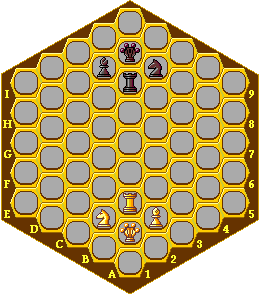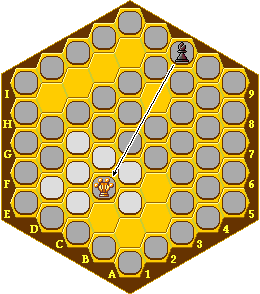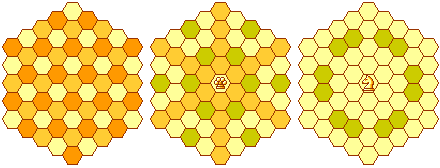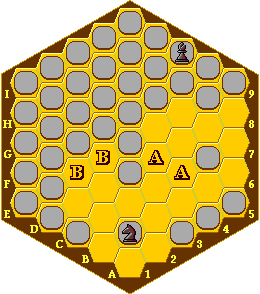HexCaïssa
HexCaïssa is a variant of Caïssa, and was invented by Dutch games designer Christian Freeling. Below, you find the rules of HexCaïssa, as written by Christian Feeling (slightly edited for the Chess Variant pages by me.)For more information on this and other games designed by Christian Freeling, and the possibility to play several of these games against others on the Internet, visit the website of Christian Freeling and Ed van Zon: Mindsports.
Rules

The diagram shows the HexCaïssa board with the pieces in the initial position. Initially, the board is covered with 61 tiles.
All play is on the tiles.
White begins. Players move, and must move, in turn.
The connection rule
The tile-complex must remain 'connected', that is, a tile or group of tiles must always remain directly or diagonally connected to the rest. The diagonal connection follows the bishop's move. (Note: a diagonal connection is actually not a connection in a traditional sence: see the example of the bishops move below what is a bishops diagonal. (HB))The Queen
The King's role is played by the Queen. The diagram below shows its options for movement and capture in a non-check situation. The Queen is the only piece with the power of capture in the usual sense.

The Atlantis effect
If the Queen moves, the tile it vacates is removed in the same turn. The removal is compulsory, but it may not violate the connection rule.The Check rule
Queens that see one another along the same file or diagonal, are considered to be 'mutually in check'. It follows that neither player may effectuate this situation. Thus a Queen may protect a piece against capture by it's counterpart.The pieces
(The pieces move more or less like the pieces in Glinski's hexagonal chess. HB.) The pieces are the usual hexagonal translations, as shown in the following diagram:
Under the implicit condition of not putting its own Queen in check and the explicit condition of not violating the connection rule, a piece can always move to any of its target-squares, whether or not it is tiled, and if it is, whether or not it is occupied, and if it is, regardless of the colour of the occupying piece.
If the target-square has no tile, the piece takes its own tile with it. At the end of the move the tile-complex must still be connected.
There is no 'during the move', so the Knight in the next diagram may legally move to the cells marked A. Moving to B is of course illegal.

The mate in 1 in the next diagram shows another application of tile-surfing and the connection rule.

If the target-square has an empty tile, the piece may simply move there.
If the target-square is occupied by a friendly piece, the player must exchange the pieces.
If the target-square is occupied by an opponent's piece, the player must also exchange the pieces, but there is one exception: a switch between two pieces of the same type may not in the next turn be 'undone' by the opponent.
This, then, is (Hex)Caïssa's unique way of mutual capture between pieces, capture by exchange, which is in fact no capture at all. The necessity of the last rule should be obvious. It represents a situation similar to the one that gave birth to the 'ko' rule in the game of Go.
Rules written by Christian Freeling for the Mindsports website, slightly edited for the Chess Variant Pages, and introduction added by Hans Bodlaender. Rules and images copyright Mindsports; used here with permission.
WWW page made: November 3, 1997. Last modified: February 16, 1999.
